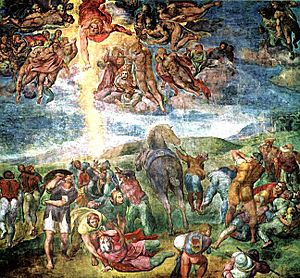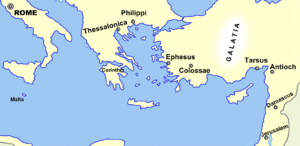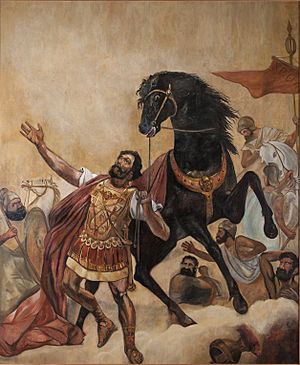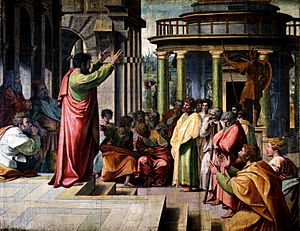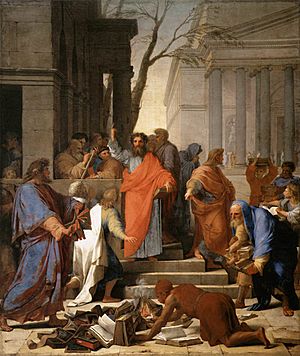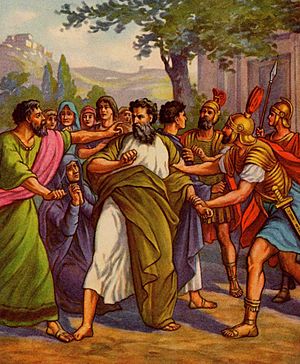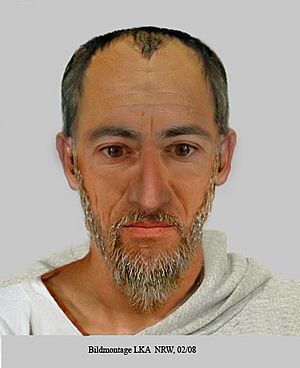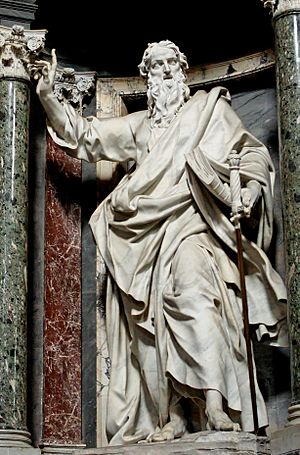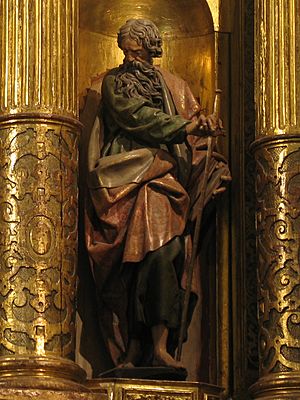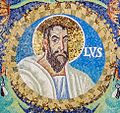Paul the Apostle facts for kids
Quick facts for kids SaintPaul the Apostle |
|||||||||||||||||||||
|---|---|---|---|---|---|---|---|---|---|---|---|---|---|---|---|---|---|---|---|---|---|
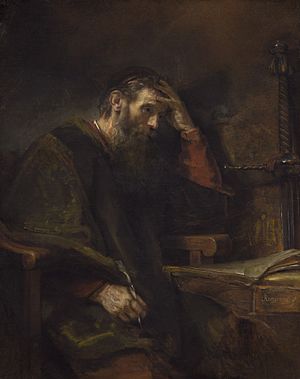
The Apostle Paul, portrait by Rembrandt (c. 1657)
|
|||||||||||||||||||||
| Apostle to the Gentiles, Martyr | |||||||||||||||||||||
| Born | Saul of Tarsus c. 5 AD Tarsus, Cilicia, Roman Empire (in present-day Mersin, Turkey) |
||||||||||||||||||||
| Died | c. 64/65 AD Rome, Italia, Roman Empire |
||||||||||||||||||||
| Venerated in | All Christian denominations that venerate saints | ||||||||||||||||||||
| Canonized | Pre-Congregation | ||||||||||||||||||||
| Major shrine | Basilica of Saint Paul Outside the Walls, Rome, Italy | ||||||||||||||||||||
| Feast |
|
||||||||||||||||||||
| Attributes | Christian martyrdom, sword, book | ||||||||||||||||||||
| Patronage | Missionaries, theologians, evangelists, and Gentile Christians
|
||||||||||||||||||||
Paul (also known as Saul of Tarsus; born around 5 AD, died around 64/65 AD) was an important apostle who helped spread the teachings of Jesus in the first century. He is considered one of the most important figures in early Christianity. Paul started many Christian communities in Asia Minor (modern-day Turkey) and Europe between the 40s and 50s AD.
Most of what we know about Paul comes from the Acts of the Apostles in the New Testament, which tells a lot about his life and work. Before he became a Christian, Paul was a Pharisee, a Jewish religious leader. He even took part in persecuting early followers of Jesus.
One day, while traveling to Damascus, Paul had a powerful experience. A bright light shone around him, and he heard Jesus' voice. This event led to his conversion. He became blind for three days, but his sight was restored by a man named Ananias of Damascus. After this, Paul was baptized and began telling everyone that Jesus was the Messiah and the Son of God. He then made three long journeys to share the Christian message with non-Jewish people in places like Asia Minor, Greece, and Syria.
Paul is traditionally believed to have written 14 of the 27 books in the New Testament. These are called the Pauline epistles. Scholars generally agree that seven of these letters were definitely written by Paul. His letters are still very important for Christian beliefs and practices today.
Contents
Paul's Names
Paul's Jewish name was "Saul." He might have been named after King Saul, the first king of Israel, who was also from the Tribe of Benjamin, just like Paul. His Latin name, "Paul," means "small." He used this name when talking to people from the Greek and Roman world.
Paul was a Roman citizen. It was common for Jewish people at that time to have two names: one Hebrew and one Latin or Greek.
In the Bible, Jesus called him "Saul, Saul" during his conversion experience. Later, in the book of Acts, he is first called "Paul" when he is on the island of Cyprus. The Bible says that both names were used for him. Paul preferred to use his Roman name, Paul, because it helped him connect with the people he was trying to reach. He wanted to make his message easy for everyone to understand.
How We Know About Paul
Most of what we know about Paul comes from his own letters (called Pauline epistles) and the book of Acts of the Apostles. His letters don't say much about his life before he became a Christian. The book of Acts tells us more, but it doesn't cover everything, like how he died.
Other old writings outside the New Testament also mention Paul. These include letters from early Christian leaders like Pope Clement I and Ignatius of Antioch. There are also some later stories about Paul, but these are not always historically accurate.
Paul's Life Story
Early Years
Paul was probably born between 5 BC and 5 AD in a city called Tarsus. Tarsus was a big trading city and known for its university. Paul came from a very religious Jewish family. He said he was a "Hebrew of the Hebrews" and a Pharisee.
The Bible doesn't say much about Paul's family, but it mentions his nephew and some relatives who were Christians before him. His family had followed Pharisee traditions for many generations. Paul worked as a leather craftsman or tent-maker. This is how he met Priscilla and Aquila, who became important partners in his missionary work.
When he was young, Paul went to Jerusalem to study with Gamaliel, a famous teacher of Jewish law. Scholars believe Paul spoke Koine Greek as his first language, and he also knew Aramaic. He used ideas from Stoic philosophy in his letters to help new Christians understand the Gospel.
Persecuting Christians
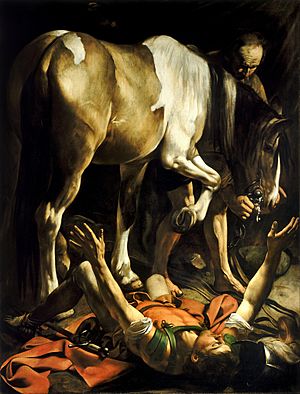
Before his conversion, Paul was very active in persecuting early Christians. He especially targeted Greek-speaking Jewish Christians who had returned to Jerusalem. He believed he was showing his strong devotion to his religion by doing this.
Paul's Conversion
Paul's life changed dramatically between 31 and 36 AD. He was on the road to Damascus when he had a powerful vision of Jesus. The Bible says he fell to the ground and heard a voice say, "Saul, Saul, why do you persecute me?" When he asked who it was, the voice replied, "I am Jesus, whom you are persecuting."
After this, Paul was blind for three days. He was led into Damascus, where he didn't eat or drink. A man named Ananias of Damascus came and laid his hands on Paul, and his sight was restored. Paul was then baptized and immediately began telling people that Jesus was the Son of God.
After His Conversion
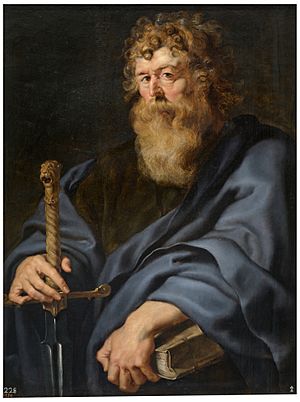
After his conversion, Paul went to Damascus. He then traveled to Arabia and later returned to Damascus. He says he barely escaped death there. Three years after his conversion, he went to Jerusalem and met James and Simon Peter.
Paul believed he received the Gospel message directly from Jesus, not from other people. He wanted to help the Christian community in Jerusalem by bringing them money from the new churches he started.
About 14 years after his conversion, Paul went to Jerusalem again. During this time, Barnabas found Paul and brought him to Antioch. Antioch became a very important center for Christians, especially for reaching non-Jewish people. It was in Antioch that followers of Jesus were first called "Christians."
First Missionary Journey
The book of Acts describes Paul's travels in three main journeys. On his first journey, Paul and Barnabas traveled from Antioch to Cyprus and then to southern Asia Minor. In Cyprus, Paul used his power to temporarily blind a magician who was speaking against their teachings.
They sailed to Perga. John Mark left them there and went back to Jerusalem. Paul and Barnabas continued to Pisidian Antioch. There, Paul spoke in the synagogue, telling the story of Jesus and how he brought forgiveness for sins. Many Jews and non-Jews wanted to hear more. When some influential Jews spoke against them, Paul announced that he would now focus his mission on the non-Jewish people (Gentiles).
Antioch was a key base for Paul's early missions. He stayed there for a long time after his first journey. This first journey is usually dated between 46 and 49 AD.
Second Missionary Journey
Paul started his second missionary journey in late 49 AD. He and Barnabas had an argument about taking John Mark with them, so they decided to go their separate ways. Barnabas took John Mark, and Silas joined Paul.
Paul and Silas visited Paul's hometown of Tarsus, and then Derbe and Lystra. In Lystra, they met Timothy, a young follower, and decided to take him along. Paul had a vision of a man from Macedonia asking for help, so they traveled there to preach. The Christian communities grew stronger every day.
In Philippi, Paul and Silas were put in jail after Paul helped a servant girl. A miraculous earthquake opened the prison gates, but they stayed. This led to the jailer becoming a Christian. They continued their travels, going to Berea and then to Athens. In Athens, Paul spoke to both Jewish people and Greek thinkers. From Athens, Paul went to Corinth.
Time in Corinth
Paul stayed in Corinth for about 18 months, around 50–52 AD. There, he met Priscilla and Aquila, who became important friends and helpers in his missions. They traveled with Paul to Ephesus and started a strong church there.
After leaving Corinth, Paul visited Cenchreae and then sailed to Ephesus. He then went to Caesarea and then north to Antioch, where he stayed for some time before starting his third journey.
Third Missionary Journey
Paul began his third journey by traveling through Galatia and Phrygia to encourage and teach the believers. He then went to Ephesus, a major Christian center, and stayed there for almost three years. He performed many miracles and organized missionary work in other areas. Paul left Ephesus after a riot started by a silversmith who was upset about Paul's teachings affecting his business. While in Ephesus, Paul wrote several letters to the church in Corinth.
Paul then traveled through Macedonia into Achaea and stayed in Greece (likely Corinth) for three months. During this time, he wrote his important letter to the Romans. He planned to go to Syria but changed his mind because of a plot against him by some Jews. On his way back to Jerusalem, Paul visited cities like Philippi, Troas, and Tyre. He ended his trip in Caesarea before finally arriving in Jerusalem.
Journey to Spain
Some early Christian writings suggest that Paul traveled even further west, possibly to Spain, after his time in Rome. Leaders like Pope Clement I and John Chrysostom mentioned Paul preaching in Spain.
Last Visit to Jerusalem and Arrest
In 57 AD, Paul arrived in Jerusalem for his last visit. He brought money collected for the local Christian community. He was welcomed at first, but some Jewish leaders were concerned that he was teaching against their laws. Paul performed a purification ritual to show he respected the law.
However, some Jews from Asia accused Paul of bringing non-Jews into the temple, which was forbidden. An angry crowd seized him. Roman soldiers rescued him but put him in chains. Paul told his story, but the crowd still wanted him gone. The tribune (a Roman officer) ordered Paul to be questioned harshly, but Paul said he was a Roman citizen, which protected him from such treatment.
The next day, Paul spoke before the Jewish council. He caused a disagreement between the Pharisees and Sadducees, and the tribune had to take him back to the barracks to prevent violence. Forty Jews then made a plan to kill Paul, but his nephew heard about it and warned him. Paul told the tribune, who sent him safely to Caesarea to Governor Felix.
Paul was held in Caesarea for two years. When a new governor, Porcius Festus, arrived, Jewish leaders asked for Paul to be sent back to Jerusalem for trial. Paul, as a Roman citizen, used his right to "appeal to Caesar," meaning he wanted his case heard in Rome.
On his way to Rome, Paul's ship was caught in a storm and shipwrecked on the island of Malta. The islanders were very kind to him. From Malta, he traveled to Rome.
Two Years in Rome
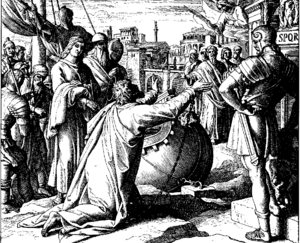
Paul finally arrived in Rome around 60 AD. He spent two more years under house arrest, meaning he could live in a rented home but was guarded. The book of Acts ends with Paul preaching in Rome while waiting for his trial.
Paul was not the first to bring Christianity to Rome; there were already Christians there when he arrived. He played a supporting role in the Roman church.
Paul's Death
Paul is believed to have died after the Great Fire of Rome in 64 AD, but before 68 AD. Some ancient writings say he was arrested in Troad and brought back to Rome, where he was put on trial and imprisoned.
Early Christian writers like Pope Clement I and Ignatius of Antioch say Paul was martyred (killed for his faith). Eusebius, an early church historian, says Paul was killed during the persecution under Emperor Nero, at the same time as Peter. Other writers say Paul was beheaded, like John the Baptist.
A legend says that after Paul was beheaded, his head bounced three times, and a spring of water appeared each time it touched the ground. This is why the place is called "San Paolo alle Tre Fontane" (St Paul at the Three Fountains).
Paul's Burial Place
Paul's body is believed to be buried outside the walls of Rome, on a property owned by a Christian woman named Lucina. In the 4th century, Emperor Constantine the Great built a church there. The current Basilica of Saint Paul Outside the Walls stands on that spot.
In 2002, a marble coffin with the words "Paul apostle martyr" was found during excavations around the Basilica. In 2009, Pope Benedict XVI announced that tests on bone fragments inside the sarcophagus showed they were from the 1st or 2nd century, supporting the idea that it is Paul's tomb.
Church Celebrations
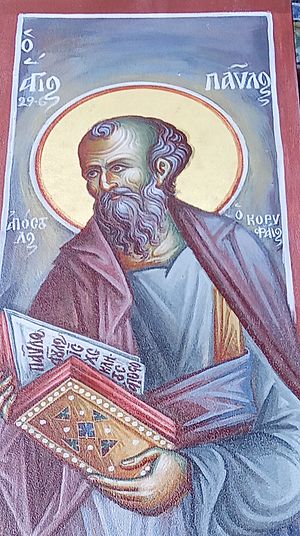
Many Christian churches celebrate Paul.
- The Roman Catholic Church celebrates his conversion on January 25. They also celebrate a special day for both Peter and Paul on June 29, remembering their martyrdom.
- The Eastern Orthodox Church has several days to remember Paul, including June 29 (with Peter) and June 30 (with the Twelve Apostles).
- The Church of England and the Lutheran Church–Missouri Synod also celebrate Paul's conversion on January 25 and a festival for Saints Peter and Paul on June 29.
Paul is the Patron Saint of Malta, where his shipwreck is celebrated on February 10, which is a public holiday. He is also considered the Patron Saint of the city of London.
What Paul Looked Like
The New Testament doesn't say much about Paul's appearance. However, some older, non-biblical texts describe him. One text, the Acts of Paul, says he was "A man of small stature, with a bald head and crooked legs, in a good state of body, with eyebrows meeting and nose somewhat hooked." Other descriptions mention he had a red or ruddy face and shining bald head with red hair.
Paul's Writings
Out of the 27 books in the New Testament, 13 are named after Paul as the author. Seven of these letters are widely accepted by scholars as definitely written by Paul himself. These are considered the most important sources for understanding Paul's life and ideas.
Paul wrote these letters to specific churches to help them with problems or questions they had. For example, if the church in Corinth hadn't had issues with their worship, we might not know Paul's thoughts on certain practices. His letters give us the first written ideas about what it means to be a Christian and how to live a Christian life. They are considered some of the most important books in the New Testament, after the Gospels of Matthew and John.
Paul's letters were written around the middle of the 1st century.
Who Wrote Paul's Letters?
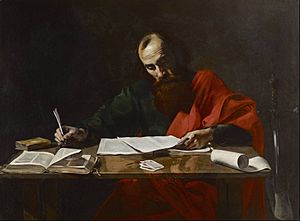
Seven of the 13 letters that carry Paul's name are almost certainly written by him: Romans, 1 Corinthians, 2 Corinthians, Galatians, Philippians, 1 Thessalonians, and Philemon. These are the best sources for understanding Paul's thoughts.
Some scholars believe that four other letters (Ephesians, 1 and 2 Timothy, and Titus) might have been written by Paul's followers after his death, using his ideas. The authorship of two others (Colossians and 2 Thessalonians) is also debated. This doesn't mean they aren't important, but it suggests they might have been written by people who knew Paul well and wanted to continue his teachings.
Paul in the Book of Acts
The book of Acts tells a lot about Paul's life, but it doesn't mention him writing letters. Historians think the author of Acts didn't have access to Paul's letters when writing the book. There are some small differences between what Paul says in his letters and what Acts says about him. This suggests that the author of Acts might have gathered information from different sources or focused on different aspects of Paul's story.
Paul's Beliefs
How Paul Saw Himself
Paul saw himself as chosen by God to spread the message of Jesus to non-Jewish people. He described his conversion as a sudden, powerful change that came from God's grace. He didn't think it was something he earned or figured out on his own.
Paul also mentioned having a "thorn in the flesh," which was some kind of difficulty or illness, but we don't know exactly what it was. He believed that his struggles showed his closeness to Jesus and proved that his teachings were true.
What Paul Believed About Jesus
Paul's writings focused on Jesus' crucifixion, his resurrection, and his return. Paul believed Jesus was the Lord, the true Messiah, and the Son of God, promised long ago by prophets. He taught that Jesus' death was not a defeat but a sacrifice that helped believers and freed them from sin.
Paul believed that Jesus' resurrection was extremely important because it promised salvation to those who believed. He taught that when Jesus returned, those who had died believing in him would be raised, and those still alive would meet him.
Paul's main message was:
- God sent his Son, Jesus.
- Jesus was crucified and resurrected to help all people.
- Jesus would return soon.
- Those who belonged to Jesus would live with him forever.
Paul also taught that people should live by high moral standards.
Forgiveness of Sins
Paul taught that Christians are saved from sin by Jesus' death and resurrection. He believed Jesus' death was a willing sacrifice that brought people back into a good relationship with God. Through God's grace and faith, Christians share in Jesus' death and his victory over death, receiving a new, righteous standing as God's children.
Before his conversion, Paul thought non-Jews were outside God's special agreement with Israel. After his conversion, he believed that both non-Jews and Jews could be united as God's people through Jesus.
Paul and Jewish Law
Paul believed that faith in Jesus was the only thing needed for salvation, for both Jews and non-Jews. He argued that non-Jewish Christians did not need to follow Jewish dietary rules or other laws from the Old Testament to be saved. This idea helped Christianity become a separate religion from Judaism.
The End of the World
Paul believed that Jesus would return during his lifetime. He expected that Christians who had died would be resurrected to join God's kingdom, and those still alive would be transformed with new, perfect bodies.
Paul's teachings about the end of the world are clearest in his letters to the Christians in Thessalonica. He told them that the dead would rise first, followed by those still alive. He didn't give exact times but encouraged them to be ready.
The Role of Women
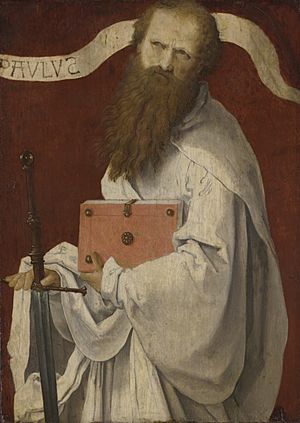
Some of Paul's letters have been interpreted in different ways regarding the role of women in the church. One passage in 1 Timothy (a letter whose authorship is debated) has been used by some to limit women's roles in church leadership.
However, other scholars point to evidence in Paul's letters that shows women played very important roles in the early church. In Romans 16, Paul praises Phoebe as a "deacon" and Junia as "prominent among the apostles." This shows that Paul valued women's contributions.
Paul also worked closely with Priscilla and Aquila, a married couple who were important partners in his ministry. Priscilla's name often appears first, suggesting she might have been a leader in their work. Many women were key supporters of the early Christian movement.
Paul's letter to the Galatians says: "There is neither Jew nor Gentile, neither slave nor free, nor is there male and female, for you are all one in Christ Jesus." This verse suggests that in Christ, traditional divisions, including those between genders, are overcome.
Paul's Impact
Paul's ideas have had a huge impact on Christian thought, perhaps more than any other New Testament writer. He taught that "Christ is the end of the law" and described the Christian church as the "body of Christ." His writings also include the earliest mention of the "Lord's Supper," which is now known as Christian communion or Eucharist.
Paul's influence can be seen in almost every church service today, from the songs and prayers to the rituals of baptism and communion.
Paul and Other Christian Thinkers
Many important Christian thinkers have been deeply influenced by Paul.
- Augustine of Hippo, a very important early Christian leader, was inspired by Paul's letter to the Romans. His ideas about God's grace and salvation came from Paul.
- During the Reformation, Martin Luther was greatly influenced by Paul's writings, especially the book of Romans. Luther's idea that salvation comes through faith alone (sola fide) was based on Paul's teachings.
- John Calvin, another key figure in the Reformation, said that the Book of Romans helps anyone understand the entire Bible.
Some modern thinkers believe that Paul's teachings are different from Jesus' teachings found in the Gospels. Some even call Paul the "second founder" of Christianity because of his huge impact on shaping the religion.
Other Views on Paul
Jewish Views
Jewish thinkers have recently shown more interest in Paul. Before the 18th and 19th centuries, he wasn't often discussed in Jewish writings. Now, he is seen as a key figure in understanding the relationship between Judaism and Christianity. Some Jewish scholars see him as someone who created barriers between the two religions, while others see him as someone who could build bridges.
Muslim Views
Some Muslims believe that Paul intentionally changed Jesus' original teachings. They argue that he introduced ideas like polytheism (believing in many gods) into Christianity. Some Muslim scholars have criticized Paul for this.
Other Critics
Some critics, like former US President Thomas Jefferson, believed Paul corrupted Jesus' original teachings. Christian anarchists like Leo Tolstoy also held similar views.
In the Baha'i Faith, scholars have different opinions on Paul, debating whether he changed Jesus' message or truly delivered the Gospel.
Images for kids
-
What is believed to be the house of Ananias of Damascus in Damascus
-
St. Paul's grotto in Rabat, Malta
-
Russian Orthodox icon of the Apostle Paul, an 18th-century iconostasis of Jesus' transfiguration in the Kizhi Monastery in Karelia, Russia
-
Paul the Apostle, detail of the mosaic in the Basilica of San Vitale, Ravenna, 6th century
-
A statue of Paul holding a scroll, symbolising the Scriptures, and a sword, symbolising his martyrdom
See also
 In Spanish: Pablo de Tarso para niños
In Spanish: Pablo de Tarso para niños


